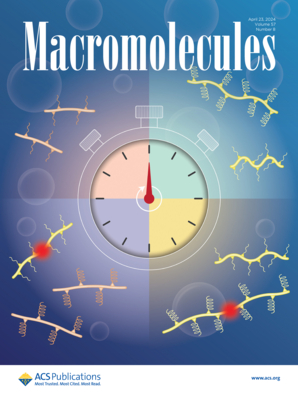Atomic-Scale Imaging of Condensed Counterions
IF 5.2
1区 化学
Q1 POLYMER SCIENCE
引用次数: 0
Abstract
The functioning of a wide variety of charged macromolecules, from DNA to fuel cell membranes, is dependent on how the counterions surrounding them are arranged. In order to decrease Coulombic repulsion, some of the fixed charges on these molecules are neutralized by a fraction of the counterions─this phenomenon is called counterion condensation. The nature of counterion condensation can be only be inferred indirectly from traditional experiments such as X-ray scattering and modern experiments such as single molecule electrometry. The prevalent conclusion in the literature, based on both theory and experiment, is that the distribution of counterions is peaked right next to the macromolecule, i.e., condensation results in the formation of contact ion pairs. In this study, cryogenic electron microscopy (cryo-EM) was used to study the arrangement of condensed halide counterions near a positively charged polypeptoid nanofiber. The locations of both condensed and fixed charges were determined directly from atomic-scale images. Our experimentally determined counterion distributions were peaked at distances of about 5 Å away from the fixed positive charge, indicating the presence of a layer of water molecules between condensed ion pairs. We posit that this distribution is driven by the entropy of the condensed ions.

凝聚反离子的原子级成像
从 DNA 到燃料细胞膜,各种带电大分子的功能都取决于其周围反离子的排列方式。为了减少库仑斥力,这些分子上的部分固定电荷会被一部分反离子中和--这种现象被称为反离子凝聚。反离子凝聚的性质只能通过 X 射线散射等传统实验和单分子电学等现代实验来间接推断。文献中基于理论和实验得出的普遍结论是,反离子的分布在大分子旁边达到峰值,即凝聚的结果是形成接触离子对。本研究利用低温电子显微镜(cryo-EM)研究了带正电荷的多肽基纳米纤维附近缩合卤化物反离子的排列。凝聚电荷和固定电荷的位置都是直接通过原子尺度图像确定的。我们通过实验确定的反离子分布在距离固定正电荷约 5 Å 处达到峰值,表明在凝聚离子对之间存在一层水分子。我们认为这种分布是由凝聚离子的熵驱动的。
本文章由计算机程序翻译,如有差异,请以英文原文为准。
求助全文
约1分钟内获得全文
求助全文
来源期刊

Macromolecules
工程技术-高分子科学
CiteScore
9.30
自引率
16.40%
发文量
942
审稿时长
2 months
期刊介绍:
Macromolecules publishes original, fundamental, and impactful research on all aspects of polymer science. Topics of interest include synthesis (e.g., controlled polymerizations, polymerization catalysis, post polymerization modification, new monomer structures and polymer architectures, and polymerization mechanisms/kinetics analysis); phase behavior, thermodynamics, dynamic, and ordering/disordering phenomena (e.g., self-assembly, gelation, crystallization, solution/melt/solid-state characteristics); structure and properties (e.g., mechanical and rheological properties, surface/interfacial characteristics, electronic and transport properties); new state of the art characterization (e.g., spectroscopy, scattering, microscopy, rheology), simulation (e.g., Monte Carlo, molecular dynamics, multi-scale/coarse-grained modeling), and theoretical methods. Renewable/sustainable polymers, polymer networks, responsive polymers, electro-, magneto- and opto-active macromolecules, inorganic polymers, charge-transporting polymers (ion-containing, semiconducting, and conducting), nanostructured polymers, and polymer composites are also of interest. Typical papers published in Macromolecules showcase important and innovative concepts, experimental methods/observations, and theoretical/computational approaches that demonstrate a fundamental advance in the understanding of polymers.
 求助内容:
求助内容: 应助结果提醒方式:
应助结果提醒方式:


